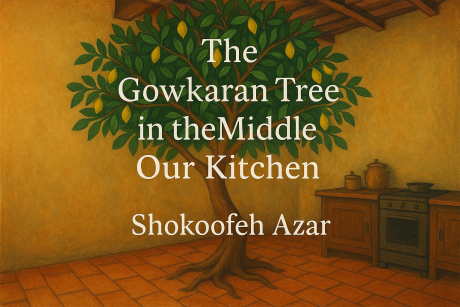The Gowkaran Tree: A Journey Through Iranian History
BOOKS REVIEW
Chaifry
7/16/20255 min read


Shokoofeh Azar’s The Gowkaran Tree in the Middle of Our Kitchen is a captivating masterpiece of magical realism, intertwining personal stories with the tumultuous history of modern Iran. Published in 2025 by Europa Editions, this novel builds on Azar’s reputation established by her debut, The Enlightenment of the Greengage Tree, which earned nominations for the International Booker Prize and Stella Prize. As an Iranian-Australian writer and political refugee who became the first Iranian woman to hitchhike the Silk Road, Azar brings authenticity and depth to her exploration of cultural displacement and resistance. Set against the 1979 Iranian Revolution’s aftermath, the narrative follows a Zoroastrian family navigating love, loss, and heritage preservation in a transformed nation.
Shokoofeh, the young narrator, guides readers through a world where myth and reality converge, symbolized by a gowkaran tree that emerges in their kitchen, described as “Leafy. Thriving. Home to a thousand birds” (Azar, 2025, p. 14).
This review posits that The Gowkaran Tree in the Middle of Our Kitchen is essential reading for its poetic exploration of resilience, cultural identity, and the interplay between the living and the dead, offering universal insights through a Persian lens.For Indian readers, the novel resonates deeply, echoing their experiences of cultural diversity, colonial legacies, and minority struggles in a pluralistic society. Its evocative prose and mythological richness bridge Persian and Indian storytelling traditions, urging reflection on heritage and familial bonds. This work is a compelling call to engage with shared human struggles while celebrating cultural specificity, making it a must-read for those seeking profound literary experiences.
The novel unfolds in a Zoroastrian mansion on an Iranian village’s outskirts, where a mystical gowkaran tree, “erupting in a mansion, [where] the residents build a table around it” (Azar, 2025, p. 14), symbolizes cultural continuity. Spanning 1976 to the present, the story is narrated by Shokoofeh, a fifteen-year-old grappling with her love for Behnam and the socio-political shifts post-revolution. Her family, led by a scholarly father and a matriarch tending a sacred fire, embodies their faith’s endurance, “quite literally keeping the flame alive” (Azar, 2025, p. 22). The narrative traces twelve children who vanish in a mysterious palace, their fates intertwining with Shokoofeh’s coming-of-age journey.
Zoroastrian mythology infuses the story, with the living and dead coexisting, as seen when “the dead and the living help her to grow” (Azar, 2025, p. 87). Shokoofeh encounters mythical figures like Eblis, “a mysterious woman of mythic power who appears in different guises” (Azar, 2025, p. 112), guiding her through war and loss. The revolution disrupts their idyllic life, bringing authorities’ scrutiny and the disappearance of their son, prompting Shokoofeh’s quest to find him. This journey reveals the regime’s brutality, where “supposedly religious men… take advantage of their position to attain wealth and satisfy sexual urges” (Azar, 2025, p. 145). The gowkaran tree represents “the richness of Iranian culture in the face of Islamic hegemony” (Azar, 2025, p. 178), anchoring their resistance. A narrative shift two-thirds through leaps into the future, diverging from Shokoofeh’s perspective before returning with deeper insight. The novel concludes hopefully, affirming that “surviving the Iranian republic is possible” (Azar, 2025, p. 312), as the family’s cultural pride endures.
Azar’s work excels in blending magical realism with historical commentary, akin to Salman Rushdie’s Midnight’s Children. The prose is luminous, capturing Shokoofeh’s passion vividly: “At the mere idea of talking to him, my entire body came out in blisters because of the heat, my hair caught fire, and my cheeks were roasted with shame” (Azar, 2025, p. 203). The gowkaran tree, “home to a thousand birds” (Azar, 2025, p. 14), mirrors Indian symbols like the banyan tree, resonating with readers familiar with sacred natural motifs. This cultural parallel enhances its appeal for Indian audiences, who recognize spiritual interconnectedness in their traditions.
The novel’s socio-political critique is sharp, exposing post-revolutionary hypocrisy through scenes like Shokoofeh’s encounters with corrupt officials, highlighting “the brutality of war, naturally, with young men sent to their deaths” (Azar, 2025, p. 145). The Zoroastrian family’s perspective illuminates minority struggles, paralleling India’s Parsi or Jain communities. The non-linear structure mirrors Iran’s chaotic reality, creating a layered narrative that invites re-reading, as noted: “If ever there was a book that needs to be read more than once, this is it” (Azar, 2025, p. 289). The interplay between the living and dead, where “human and humane bonds [remain] unbroken even in death” (Azar, 2025, p. 301), echoes Indian beliefs in ancestral continuity, enhancing emotional resonance.
The novel’s density can challenge readers, as a Goodreads reviewer noted: “became overwhelmingly dense… leaving [them] completely disoriented” (Goodreads, 2025). The palace of mirrors section, where “I had lost myself amid the hallways and rooms and children” (Azar, 2025, p. 203), reflects narrative disarray. The future-oriented shift, described as “a different story” (Azar, 2025, p. 167), disrupts continuity, potentially alienating readers seeking cohesion. The large cast, including the white-haired sister who “swings in the tree and vanishes” (Azar, 2025, p. 92), lacks depth, risking emotional dilution. For Indian readers accustomed to epics, this may be less jarring, but the novel’s scope can feel overwhelming.
The reliance on magical realism may confuse readers unfamiliar with the genre, especially in Eblis’s abstract appearances. The anonymous translation raises concerns about cultural nuance fidelity, potentially affecting Indian readers seeking precise parallels. The broad scope—war, love, mythology—can feel “almost bursting at the seams” (Azar, 2025, p. 167), challenging focus.
Why Indian Readers Must Read This Book
Indian readers will find The Gowkaran Tree in the Middle of Our Kitchen profoundly resonant due to its parallels with India’s cultural and historical landscape. The Zoroastrian family’s struggle to preserve their heritage mirrors India’s minority communities, particularly Parsis, sharing Zoroastrian roots. The gowkaran tree evokes the banyan or peepal tree, revered in Hindu and Jain traditions as symbols of resilience and spiritual interconnectedness, inviting reflection on cultural preservation.
The novel’s exploration of familial bonds and the living-dead interplay resonates with Indian practices like shraddha rituals or the Mahabharata’s cyclical life view. Shokoofeh’s journey, marked by “revelations about violence under the new regime” (Azar, 2025, p. 87), parallels Indian women’s struggles against patriarchal and political constraints, from Partition to modern secularism debates. Azar’s critique of authoritarianism echoes India’s post-colonial resistance to hegemonic narratives, relevant to diverse communities like Sikhs or Adivasis.
Azar’s refugee experience adds authenticity, resonating with Indian diaspora communities like Parsis or Tibetans maintaining cultural ties. The novel’s mythological framework bridges Persian and Indian storytelling, recalling Panchatantra or Kathasaritsagara. Its lush prose invites Indian readers to explore shared struggles while celebrating cultural identity. This novel is a vital read for those reflecting on India’s pluralistic heritage and the resilience needed to preserve it in a globalized world, offering a poignant literary journey through shared human experiences.
The novel shines in Shokoofeh’s meeting with Behnam, resonating with Indian love stories like Devdas. The gowkaran tree’s integration into daily life mirrors Indian reverence for the peepal tree. However, the palace of mirrors section overwhelms with clutter, and the future shift disrupts emotional flow, potentially lessening impact for readers expecting a cohesive saga.
The Gowkaran Tree in the Middle of Our Kitchen is a luminous novel blending magical realism with historical insight, exploring cultural survival and resilience. Its poetic prose, mythological depth, and socio-political commentary make it a vital contribution to world literature, despite occasional density and an overcrowded cast. Azar’s ability to craft “a wildly ambitious novel about Iran’s past, present, and future filled with longing and fury” (Kirkus Reviews, 2025) ensures universal appeal. This reviewer recommends it to those who appreciate evocative storytelling bridging personal and political narratives.
